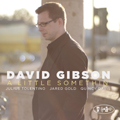Trombonist David Gibson has paired together with Marc Free of Posi-tone Records to release “End of the Tunnel.” Gibson is joined by Julius Tolentino on alto saxophone; Jared Gold on organ and Quincy Davis on drums. The release date is set for May 31, 2011.
“End of the Tunnel” features several compositions by Gibson and Gold as well as a couple songs by Herbie Hancock and Jackie McLean. The ensemble appears to play mainly traditional, straight-ahead jazz set to the backdrop of an organ trio. However, they often break from tradition to embark on more adventurous excursions.
Blind Man, Blind Man begins as a funky organ groove. Gibson and Julius Tolentino do the less common pairing of trombone and alto saxophone well here. Tolentino’s sound and bluesy lines are familiar, yet not derivative of one particular player. It is particularly interesting to note that the melodies as well as solos are relatively concise throughout “End of the Tunnel.” The solos are short, sweet and straight to the point. The collective musicians don’t seem to waste a single note nor meander in one place too long.
Funky Wasabi takes us to a familiar place somewhere between The Jazz Crusaders and Tower of Power. Tolentino on alto saxophone solos first followed by Gibson on trombone. Tolentino’s sound is clear, neither bright nor dark – just a great alto sound. His lines are interesting and never overstated. Gibson shows great dexterity and rhythmic interest on his trombone. Jared Gold solos last, demonstrating his wonderful command of the Hammond B3 and it’s funky capabilities.
The relaxed and aptly titled Sunday Morning first features Gibson on trombone followed by Gold on the organ. The group never becomes overly excited, rather opting to just lay it down. Trombone and alto join in behind Gold’s chorus, which leads back into the final melodic statement.
The title cut sets off with a short statement of the melody followed by another fascinating and energetic solo by Gold. Gibson then improvises with short bursts on the trombone. By contrast, Tolentino weaves together a tapestry of flowing lines on the alto sax. Behind all solos drummer Quincy Davis supports and pushes from behind the drums. Ultimately, Davis gets a ride of his own, peppered with rhythmic pads from Jared Gold on the organ. Davis’ displays his quick hands just before and abrupt end to End of the Tunnel.
A Place of Our Own is a slow and sustained anthem that offers a distinct contrast from the otherwise funky, grooving or swinging cuts found elsewhere on “End of the Tunnel.” Gibson and Tolentino moan musically as Gold and Davis percolate in the background – eventually fading out.
The slick triplet figures on the inaugural melodic statement of Splat lead into a disjointed swing behind Gibson’s trombone solo. Tolentino’s again strings together a series of flowing lines over a somewhat swinging rhythm section. It seems Gold and Davis never completely engage Tolentino in his lines. Gold solos last before the appealing triplet figures of the melody return. The group collectively states some bluesy figures and kicks leading up to the final fermata.
The unison and harmony of Gibson and Tolentino announce the arrival of In-Whim. The arrangement here seems well calculated however the improvisational nature of the ensemble allows great freedom for all within it. Tolentino takes it out with more energy and angst than previously heard. Things all but come to a stop prior to Gibson’s initially restrained trombone solo. Gibson later visits the outer limits as he explores more experimental sounds and reaches higher and higher in the register of the trombone.
Preachin’ slowly swings along and brings the group to more familiar territory. The group maintains a nice balance between remaining true to the “preachy” groove and taking things to a more experimental and improvisational level. This is evident in both solos by Gibson and Gold. The final vamp evokes images of New Orleans jazz and Gospel music at the same time – quite an interesting mix.
Fast and swinging is Blue Rondo, which allows for brief solo exchanges by Davis, Tolentino and Gibson. Gold accompanies beautifully. The group is obviously taking us on a musical journey however the destination may be unclear. Davis again demonstrates quick hands and feet before the short repeat of the melody.
As with many of the current offerings from Posi-tone Records, David Gibson’s “End of the Tunnel” showcases a cast of highly talented jazz musicians creating fresh, new music. The overwhelming characteristic here seems to be the way in which this ensemble is able to make their complete statements so concise. Barely a note is wasted. The melodies and solos are relatively short for a jazz recording. Certainly each member of the group is capable of taking chorus after chorus to make their point – they just don’t have to.


